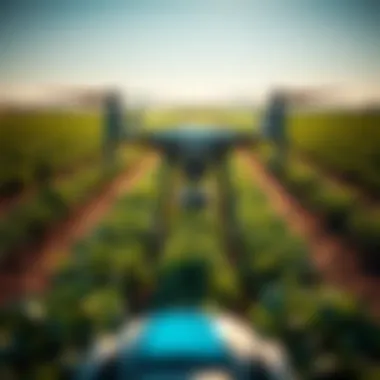Robotic Process Automation in Agriculture: Enhancing Efficiency


Intro
In recent years, agriculture has faced the challenge of balancing efficiency with sustainability, a quest not easily achieved. Robotic Process Automation (RPA) has emerged as a key player in this landscape, redefining how agricultural tasks are approached. By automating routine processes, RPA enables farmers to focus on more strategic roles, ultimately enhancing productivity and sustainability. This article provides a deep dive into the various facets of RPA in agriculture, aiming to equip both industry professionals and enthusiasts with a solid grasp of this transformative technology.
Key Concepts and Terminology
Definition of Terms
To get into the guts of RPA in agriculture, it’s essential to understand some basic terms.
- Robotic Process Automation (RPA): This refers to the technology that allows the automation of repetitive tasks through software robots (or bots). In agriculture, this could mean automating processes such as data entry, inventory management, or even monitoring crop health.
- Agricultural Automation: While RPA targets office tasks, agricultural automation spans a broader spectrum. This includes the use of machinery for planting, harvesting, and other field operations.
Overview of Relevant Practices
There are various practices under the RPA umbrella that are worth noting:
- Process Mapping: Visualizing agricultural processes to identify areas ripe for automation.
- Integration with IoT: The Internet of Things plays a vital role in enabling RPA by supplying real-time data from field sensors, tractors, and drones.
- Data Analytics: Automated collection and analysis of data assist farmers in making informed decisions.
Current Trends and Innovations
Latest Research and Developments
As farmers strive to enhance productivity, stay ahead of the curve, and adhere to sustainability goals, research in RPA is ramping up. Innovations often emerge from collaborations between tech companies and agricultural research institutions. For instance, studies have shown how integrating RPA with drone technology enables efficient monitoring of crop health. Many are exploring machine learning algorithms that enhance the functionality of RPA systems, enabling them to learn and adapt over time.
Emerging Technologies and Tools
A few exciting technologies are giving RPA in agriculture a big boost:
- Precision Agriculture: Improves yield prediction and resource allocation by standing on the shoulder of RPA giants.
- Blockchain: Enhances transparency and security in supply chains, which complements RPA's efficiency fact.
- Farm Management Software: Tools like Trimble or AG Leader are integrating RPA to help farmers manage their operations seamlessly.
Practical Applications
Step-by-Step Guides
Here’s what’s essential for getting started with RPA in your agricultural practice:
- Identify Processes: Start by assessing your daily operations and find processes that are time-consuming or repetitive.
- Choose the Right RPA Tool: There are several tools available tailored for farming operations—evaluate them based on specific needs.
- Pilot the Automation: Instead of a full rollout, conduct a pilot with one farming aspect to fine-tune the automation process before wider implementation.
- Training: Ensure your staff receives proper training on how to operate new software tools, which can help bridge the technology gap.
Troubleshooting Common Issues
As with any technology, hiccups are bound to happen. Here are a few common issues and their solutions:
- Integration Challenges: If RPA tools aren’t aligning with existing systems, consult tech support for compatibility solutions.
- Data Quality Issues: Garbage in, garbage out. Ensure that your data collection methods are accurate to avoid poor decision-making.
- Staff Resistance: Address any worries your team might have through clear communication and highlighting how RPA eases their workload.
"Robotic Process Automation converts mundane into manageable, allowing the farmer to play a strategic game."
With its roots firmly planted in modern technology, Robotic Process Automation is reshaping the agricultural sector, ushering it into a new era of productivity and sustainability. Understanding these concepts, current trends, and practical applications equips you with a roadmap for utilizing RPA in your agricultural practices. For further insights and resources, visit Wikipedia, Britannica, or explore discussions on Reddit.
Stay tuned as we delve deeper into how RPA can be a cornerstone for future farming practices.
Understanding Robotic Process Automation
Robotic Process Automation (RPA) is revolutionizing the way various industries manage their repetitive tasks. In agriculture, this technology is proving to be an invaluable asset. Understanding RPA not only illuminates its potential but also lays the groundwork for agricultural professionals to harness its power effectively. The concept of automating manual processes to enhance efficiency is not merely a trend; it's a necessity in modern agriculture. This section delves into what RPA truly embodies and how it operates within the agricultural sphere.
Defining RPA
Robotic Process Automation can be described as the use of software robots or "bots" to automate routine tasks. Essentially, it mimics human actions to execute repetitive processes without the need for human intervention. RPA can manage data entry, process transactions, and even replicate simple decision-making tasks based on pre-defined rules. For agricultural practices, where time and resources are often limited, RPA stands as a beacon of opportunity for operational efficiency.
The implementation of RPA can vary, but its core function remains the same—freeing up human resources to engage in more complex, value-added activities rather than getting bogged down by mundane chores. Think of it as a field worker leveraging the latest technology to plant seeds in rows—systematic, precise, and less time-consuming.
How RPA Works
RPA operates through a series of software algorithms designed to mimic human interactions with digital systems. To visualize it, picture a farmer who pulls up weather data to decide when to plant crops. Instead of manually scrolling through websites or databases, an RPA system can be programmed to pull this information automatically, interpret it, and present actionable insights all within a fraction of the time.
Implementing RPA generally follows these steps:
- Identification of Repetitive Tasks: Agricultural tasks that consume significant time and require minimal decision-making are prime candidates for automation.
- Bot Development: Based on the identified tasks, bots are created using specialized software platforms, such as UiPath or Automation Anywhere.
- Integration with Existing Systems: Successful RPA deployment necessitates seamless integration with existing software systems used in farms or agricultural companies. For instance, ERP (Enterprise Resource Planning) systems can work hand-in-hand with RPA tools.
- Monitoring and Optimization: After deployment, ongoing monitoring is essential to ensure the bots operate effectively and adjustments can be made as required.
In summary, understanding RPA is not just about grasping its definition but also about how it fundamentally transforms agricultural operational efficiencies. A farmer's commitment to embracing this technology can make all the difference in their productivity and sustainability in the field.


"By adopting Robotic Process Automation, farmers are not just keeping pace with technology; they are setting the pace for future agricultural advancements."
For more information about RPA and its applications, you can check these resources:
- Wikipedia on Robotic Process Automation
- Britannica on Automation
- Reddit discussions on RPA
- USDA Agricultural Resources
- EPA on Sustainable Practices
This foundation of knowledge not only catalyzes a shift in operational methodologies but also paves the way for a more innovative approach to agriculture.
The Role of RPA in Agriculture
In today’s bustling agricultural landscape, the introduction of Robotic Process Automation (RPA) is becoming more than just a trend; it’s an evolution in how farming operations function. The significance of RPA within agriculture cannot be understated, as it stands at the forefront of enhancing operational efficiency and productivity.
RPA allows agricultural specialists to automate mundane but essential tasks. This ranges from data entry to order processing and supply chain management, freeing up valuable time and resources. It permeates various agricultural activities, making it necessary for farmers and agri-business professionals to grasp its benefits and implications deeply.
Enhancing Workflow Efficiency
One of the most impactful advantages of RPA is its capacity to streamline workflow. Farmers often find themselves bogged down with repetitive tasks, such as inventory management, scheduling, or even data collection from multiple sources. This can lead to human error, inefficiencies, and an overall drain on resources.
By incorporating RPA tools, tasks that were once time-consuming and prone to mistakes can be handled with precision and speed. For instance, imagine a cultivator who spends hours manually inputting data from crop yield reports into a system. With RPA, this data can be automatically collected and processed, significantly reducing the time spent on administrative duties.
Here are a few specific ways RPA enhances workflow:
- Automated Data Entry: Automation can swiftly input data into various systems. This minimizes errors and ensures consistency.
- Task Scheduling: RPA can manage schedules by automatically creating reminders for watering, pest control, or harvesting, leading to timely actions.
- Reporting: Automated systems can generate reports on crop status or production levels, providing real-time data without manual oversight.
As a result, labor resources can be redirected towards more strategic endeavors, ultimately improving productivity and profitability.
Data Management and Analysis
Data is the lifeblood of modern agriculture, where every decision can affect yields and profits. However, managing vast amounts of data is often challenging without the right tools. RPA comes into play here as well, offering exciting opportunities for data management and analysis.
An agricultural business may deal with different data sets, from soil conditions to market prices and customer data. The complexity of analyzing this information can overwhelm traditional methods. However, RPA facilitates the aggregation and processing of this data seamlessly.
Consider this: farmers who integrate RPA tools to collect and analyze data can make informed decisions that drive sustainable practices. By leveraging real-time data insights, farmers can optimize inputs such as water and fertilizers, ultimately enhancing yields while lowering costs.
Key advantages of RPA in data management include:
- Real-Time Analysis: Accessing and understanding data trends can lead to quicker decision-making in-field activities.
- Data Accuracy: Automated systems process data faster without human error, ensuring higher quality analysis.
- Integration: RPA can link various databases, creating a central hub for data that supports smarter farming techniques.
In summary, the role of RPA in agriculture goes beyond mere automation. It enriches workflow efficiency, providing agricultural professionals with a viable path toward increased productivity and sustainability. This transformation not only improves the operational landscape but also ensures that agriculture can meet the evolving demands of global food supply.
"RPA empowers farmers to not merely adapt to shiftin challenges, but to thrive in the dynamic agricultural ecosystem."
With these capabilities, those in the agricultural sector should carefully deliberate on how to harness RPA to reshape their operations and drive meaningful change.
Technological Frameworks Supporting RPA
As robotic process automation continues to evolve, its frameworks play a critical role in shaping the future of agricultural operations. Understanding these frameworks is paramount for those looking to adopt RPA in their practices. The right technology not only enhances process efficiency but also ensures sustainability and growth within the sector. A solid technological framework provides the backbone for reliable RPA applications, enabling farmers to leverage automation effectively.
Software and Tools for RPA
In terms of software and tools, there’s a plethora of options available, each bringing its own flavor to the automation table. Popular choices like UiPath, Automation Anywhere, and Blue Prism dominate the market, each offering unique features tailored for agricultural needs. For instance:
- UiPath: Known for its ease of use, it allows farmers to automate tasks with minimal technical knowledge. This is crucial for those who may not be tech-savvy but want to improve productivity.
- Automation Anywhere: This tool offers extensive data analysis features that can provide insight into crop yields and market conditions, empowering farmers with data-driven decision-making.
- Blue Prism: This software focuses on security and scalability, making it suitable for larger agricultural enterprises that require robust automation processes.
Investing in the right tools can result in significant time savings and fewer errors, making it easier for farmers to focus on higher-value tasks instead of mundane manual processes. Understanding the capabilities of these software options is vital for effective implementation.
Integration with Existing Systems
Integrating RPA tools with existing systems can sometimes feel like fitting a square peg in a round hole. However, it's a necessary step to ensure that automation delivers its maximum potential. Effective integration allows for the seamless flow of data across platforms, enhancing overall efficiency. Key considerations include:
- Compatibility: Ensure that the RPA tool can easily connect with current software used for planting, harvesting, and inventory management.
- Data Synchronization: Achieving real-time data updates between systems can significantly enhance decision-making processes. Farmers need to prioritize tools that facilitate such synchronization.
- User Training: It's crucial that all users understand the integrated system. Farm workers must be equipped with the knowledge to interact with both the RPA tools and existing systems, ensuring smooth operations.
Integrating RPA into the agricultural structure requires diligent planning and communication among teams. Farmers looking to embark on this journey must understand that a well-integrated system not only reduces redundancy but also maximizes the benefits of automation.
Benefits of Implementing RPA in Agriculture
Robotic Process Automation (RPA) brings a transformative approach to the agricultural sector, enhancing efficiency and productivity in ways that resonate deeply with today’s farming practices. Understanding the benefits of RPA allows agricultural professionals to grasp how technology can alleviate prevailing challenges, automate repetitive tasks, and ultimately lead to a more prosperous farming environment. This section will delve into key reasons why implementing RPA is not just beneficial but essential for modern agriculture.
Cost Reduction
One of the foremost advantages of RPA in agriculture is its ability to significantly cut down operational costs. Traditional farming practices often fall prey to labor inefficiencies and errors, leading to wasted resources. By automating routine processes—such as data entry, inventory management, and billing—RPA reduces the time spent on these tasks. Operators can allocate their budgets more efficiently, directing funds toward innovation and growth instead of bogged-down processes.


Moreover, studies show that farms employing RPA see a decrease in labor costs over time, as fewer workers are needed for manual tasks. For instance, an agricultural firm may utilize robotic systems for crop monitoring or irrigation management. By leveraging technology to handle these tasks, farm managers have the opportunity to avoid hiring additional staff, even as their operations scale.
In a nutshell, RPA can lead to cost savings, indirectly enhancing profit margins for farmers, while ensuring more of the budget is assigned to efficient practices.
Increased Accuracy and Quality
RPA's capability to enhance accuracy cannot be overstated. In agriculture, even slight discrepancies in planting schedules, nutrient levels, or pest management can lead to dire consequences. RPA eliminates human error from data handling and processing, making sure that the information regarding crops, field conditions, and market trends is reliable and up to date.
Consider this: a system set up to analyze soil quality can continually gather and process data, providing precise recommendations to farmers about fertilization. Such attributes ensure that the produce not only meets market standards but, indeed, surpasses them. Farmers can then pride themselves on delivering high-quality products, leading to improved customer satisfaction and loyalty.
Scalability of Operations
As agricultural businesses grow, they often face the challenge of scalability. Traditional farming methods may limit growth due to increased complexity in logistics, monitoring, and compliance. RPA offers a solution by facilitating the process of scaling operations without a proportional increase in labor or costs.
With RPA systems, farmers can easily integrate additional farming practices or crop types, enabling seamless data flow and process management. For instance, a farmer who expands their operation to include organic crops can adapt their existing RPA tools to accommodate changes. This flexibility allows for rapid adjustments to operational requirements, which is crucial in an industry where market demands can shift swiftly.
Challenges in RPA Adoption
In the journey towards implementing robotic process automation in agriculture, several hurdles must be surpassed. Understanding these challenges is crucial as it helps stakeholders prepare adequately, ensuring smoother transitions into the world of automation. Among the key issues are technical barriers, the impact on the workforce, and concerns around job displacement. Each of these elements presents not only obstacles but also opportunities for growth and improvement.
Technical Barriers
One of the most pressing issues faced during RPA adoption in agriculture is the technical barriers. These can arise from outdated systems that are incompatible with new automation technologies. Farmers and agricultural businesses often rely on legacy systems for their operations. This results in significant integration challenges when attempting to introduce RPA tools into these existing environments. Implementing RPA without altering current infrastructure can lead to inefficiencies and may require considerable investment in updates or overhauls.
Moreover, a lack of expertise in these technologies can stall the implementation process. Many agricultural professionals may not possess the skills necessary to operate and maintain RPA systems effectively. This can result in a reliance on external vendors or consultants, which can be both time-consuming and costly. The complexity of certain RPA solutions may also deter farmers from fully committing to this transformation.
Workforce Impact
Job Displacement Concerns
The conversation surrounding job displacement due to automation is a delicate matter. Many workers in agriculture fear that RPA will lead to job losses. While it's true that some roles may become redundant as automation takes over repetitive tasks, it’s vital to highlight the nuanced view of this issue. Job displacement does not equate to a loss of employment opportunities overall; rather, it serves as an impetus for the evolution of job roles.
By automating routine chores, farmers can reallocate human resources to more complex tasks that require critical thinking and problem-solving. For instance, while a drone might handle crop monitoring, agricultural technicians can focus on data analysis to make informed decisions.
As agriculture evolves, the demand will shift towards more skilled labor. This transition, however, must be managed prudently to alleviate fears and create a steady pathway for workers. It underscores the importance of education and awareness about how RPA can augment human capabilities rather than replace them.
Reskilling the Workforce
The key to navigating the changing landscape of agriculture lies within reskilling the workforce. As jobs transform, investing in retraining programs becomes essential. Reskilling is not only a beneficial choice but a necessary one for maintaining a viable workforce in the sector. Bridging the skills gap means allowing workers to adapt to new technologies and practices, ensuring they remain relevant in an evolving job market.
Educational programs focused on technology can empower staff to manage and utilize new RPA tools effectively. By promoting hands-on workshops and training sessions, agricultural businesses can foster a culture of continuous learning.
Additionally, engaging in partnerships with educational institutions can provide access to cutting-edge knowledge and techniques, benefiting both employees and employers. This approach creates a more adaptable workforce that is equipped to thrive in an increasingly automated industry.
"The future of agriculture depends on skilled minds adapting to advancements in technology, not just the machines themselves."
Reskilling offers a dual advantage: it mitigates the impact of job loss and enriches the workforce with diverse skills that align with future technology needs.
In summary, while challenges in RPA adoption are significant, they also present a rich ground for growth and adaptation in the agricultural sector.
Ethical Considerations in RPA Use
As the agricultural sector increasingly embraces robotic process automation (RPA), addressing the ethical considerations surrounding this technology becomes paramount. RPA brings undeniable improvements in operational efficiencies, yet its implementation raises essential questions related to transparency, data privacy, and the overall societal impact. These ethical dimensions are crucial for fostering trust among the stakeholders involved, especially the farmers and workers who interact with these robotic systems daily.
Both the advantages and potential pitfalls of RPA in agriculture require careful examination. Enhancements in productivity can lead to more resilient food supply chains; however, this comes with a responsibility to ensure ethical practices are upheld in these evolving environments.
Decision-Making Transparency
Transparency in decision-making processes is a cornerstone of ethical RPA use. As algorithms dictate various actions within agricultural practices, it is vital that farmers understand how these automated systems arrive at their conclusions. For example, when an RPA system analyzes soil data to recommend pesticide applications, stakeholders should be able to trace the logic behind such recommendations.
A lack of transparency can stir mistrust among professionals in the agriculture field. They may question whether these systems prioritize efficiency over health and environmental safety. Therefore, ensuring that algorithms are clear and easily comprehensible is essential.
Moreover, proper documentation outlining the decision-making pathways can significantly reinforce trust in technology. Organizations must not only focus on the efficiency metrics that RPA enables but also strive to cultivate a robust ethical framework around decision-making processes. This includes:
- Regular audits of RPA decisions to identify any biases or errors.
- Providing education on how these automated systems function, fostering a better understanding among users.
- Establishing feedback mechanisms to allow farmers to share their experiences and concerns regarding RPA systems.
Fostering a culture of transparency can go a long way toward minimizing fears and skepticism related to RPA in agriculture.
Data Privacy Issues
As agricultural practices leverage RPA, handling sensitive data responsibly is more critical than ever. Data privacy concerns arise from the extensive collection and analysis of personal information, whether it's regarding farmers, customers, or environmental data.


Farmers often share data with RPA systems to optimize their operations. However, if mishandled, this data can lead to significant privacy issues, such as unauthorized access or misuse of information. The risk intensifies with the rising sophistication of cyber threats and the intricate interconnections between systems that automation fosters.
To address these issues, agricultural organizations must adopt robust data privacy policies. Some effective strategies include:
- Encrypting sensitive data to protect it from unauthorized access.
- Implementing strict access controls, ensuring that only authorized personnel can access specific information.
- Offering training to users about data privacy best practices, highlighting the importance of safeguarding their data.
- Establishing protocols for data retention and deletion, ensuring that personal data is not stored longer than necessary.
"In a world increasingly driven by data, protecting farmers’ privacy isn’t just best practice; it's a moral obligation."
This ethical awareness regarding data privacy not only bolsters stakeholders' confidence in RPA but also fosters a culture of responsibility in agricultural technology.
Future Trends in RPA for Agriculture
The horizon of agriculture is always shifting, and with the integration of Robotic Process Automation (RPA), those shifts are becoming more pronounced. Future trends in RPA within this sector are not merely about the gadgets and software that farmers plug into their daily operations; they signify a shift in fundamental approaches to farming itself. As farmers grapple with the twin pressures of feeding a growing global population while staying ahead of market demands, embracing these trends can lay the groundwork for resilient and agile agricultural practices.
Advancements in AI and Machine Learning
Robotic Process Automation is rapidly evolving thanks in large part to advancements in artificial intelligence and machine learning technologies. These developments are critical because they allow RPA systems to learn from the data they process, adapting over time to improve efficiency and decision-making.
For instance, predictive analytics powered by AI can help farmers anticipate weather changes, pest invasions, or even market fluctuations. Some systems are already being tested that analyze crop health in real-time by processing images taken by drones or satellite imagery. By identifying patterns and anomalies in these images, AI can alert farmers about potential crop issues before they become major problems. This not only increases yield but also reduces resource waste.
The future therefore holds promise where farmers can automate various tasks, from planting to harvesting, using intelligent systems that continuously evolve based on real-world outcomes. These advancements create an environment where insights gathered from past harvests and conditions feed directly into improving future agricultural tactics.
"With AI and machine learning, RPA transforms the way we perceive challenges in agriculture into manageable tasks, allowing for more agility in our farming practices."
Sustainability and Environmental Impact
As global attention continues to focus on climate change and environmental sustainability, the role of RPA aligns closely with these priorities. The agricultural sector is under scrutiny for its environmental impact – from carbon emissions to water usage. RPA can play a pivotal role in mitigating these issues.
For instance, intelligent irrigation systems that incorporate RPA technologies can optimize water usage by analyzing soil moisture levels and weather forecasts. These systems can automate watering schedules to ensure crops receive precisely what they need without excess, thus conserving water.
Moreover, RPA can help in precision agriculture, where resources like fertilizers and pesticides are applied in measured doses based on real-time data. This not only minimizes chemical runoff into waterways but also promotes healthier soil and ecosystems.
In looking at the future, it’s clear that integrating RPA can foster a balance between productivity and sustainability. Farmers can focus on growing quality produce while being stewards of the land, ultimately forging a path toward sustainable agriculture.
In summary, the importance of these future trends in RPA for agriculture is not just in the technology itself, but in how it can reshape farming practices to be more efficient and responsible. As the landscape of agriculture evolves, staying abreast of these trends will be crucial for farmers looking to thrive in an ever-changing environment.
Case Studies of RPA Implementations
Case studies serve as a critical tool for understanding the practical implications of implementing Robotic Process Automation (RPA) in agriculture. They not only showcase the successes that come from embracing technology but also the hurdles faced during these transitions. Through these examples, stakeholders can grasp the real-world application of RPA, providing valuable insights into its potential and pitfalls. This section highlights the global footprint of RPA through successful implementations while also addressing the lessons learned from failed attempts, paving a clearer path for future endeavors in the sector.
Successful Implementations Globally
Around the globe, farmers and organizations are reaping the rewards of robotic process automation, reshaping their operations in startling ways. For instance, an innovative farm in New Zealand, called Silver Fern Farms, leveraged RPA to enhance its supply chain efficiency. By automating inventory management processes, they reduced order processing times by over 50%. This shift not only saved labor hours but significantly increased accuracy in stock levels, leading to less waste and improved profitability.
Another standout example is the John Deere company, known for pioneering agricultural technology. They utilized RPA to streamline customer service operations. With automated workflows for handling inquiries, the time to resolve customer issues shrank dramatically. This led to a noticeable increase in customer satisfaction scores, reflecting how RPA can enhance the relationship between businesses and their clients.
"The integration of robotic processes has transformed farming operations, turning scattered tasks into cohesive workflows that yield significant results."
Consider, too, the Aaglou cooperative in Spain, which adopted RPA to optimize its crop monitoring processes. Instead of relying solely on manual labor to inspect fields, they employed drones equipped with RPA capabilities to collect data on crop health. This technology not only reduced labor costs but provided farmers with real-time insights that are crucial for timely decision-making.
These examples underline a larger trend: implementing RPA catalyzes increased efficiency, supports sustainable practices, and enhances output—providing holistic benefits across the agricultural supply chain.
Lessons Learned from Failures
While many have successfully integrated RPA, there are also instances where the journey has had its fair share of bumps. Learning from these failures is just as crucial as celebrating successes. A notable case involved a mid-sized farming operation in the U.S. that attempted to automate their planting schedules without fully understanding the complexities involved. The failure stemmed from insufficient data—programmed processes could not adapt to the variabilities in weather or soil conditions.
This setback cost significant time and money, ultimately leading to a reevaluation of their entire technological strategy. Another case to note is that of a large agricultural firm in Brazil. They invested heavily in RPA but ignored the need for adequate training among their staff. Consequently, employees resisted the change, leading to a lack of engagement with the automated processes, which hindered productivity.
Through these experiences, several key lessons emerge:
- RPA should always be implemented with a deep understanding of the operational workflow.
- Training staff sufficiently ensures that technology complements human intelligence rather than replaces it.
- Continuous evaluation of both technology and processes is essential for long-term success.
Closure
The discussion around Robotic Process Automation (RPA) in agriculture highlights its pivotal role in reshaping the landscape of farming. Understanding the implications of RPA not only unveils pathways to improved operational efficiencies but also emphasizes the need for adoption in a world faced with growing agricultural demands. RPA stands out as a beacon of hope, particularly in managing labor shortages and enhancing productivity.
Recap of Key Insights
Overall, the key takeaways from this exploration include:
- Efficiency Gains: RPA significantly reduces time and labor costs, allowing agricultural professionals to focus on more strategic tasks rather than mundane operations.
- Data-Driven Decisions: By automating data management, farmers can glean insights more quickly and accurately than ever before. This drives better decision-making and optimizes yield.
- Sustainability Focus: RPA is not just about efficiency; it also promotes sustainability. Automated systems can help minimize waste and eco-friendly practices, supporting not only productivity but also responsible farming.
- Challenges to Consider: Implementation is not without its hurdles. Technical barriers and workforce transitions need to be managed carefully to harness RPA's full potential.
"The future of farming is not just in the land we till, but in the technology we employ to manage it."
Final Thoughts on RPA in Agriculture
As the agriculture sector stands at the crossroads of tradition and innovation, the integration of RPA is a significant step forward. The transition towards automated solutions will not only foster economic growth but also prepare the industry for the various challenges ahead, including climate change and food security. While there are bumps on the road to full adoption, the journey is well worth it.







